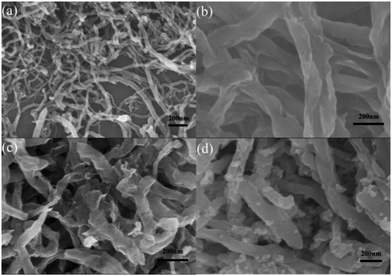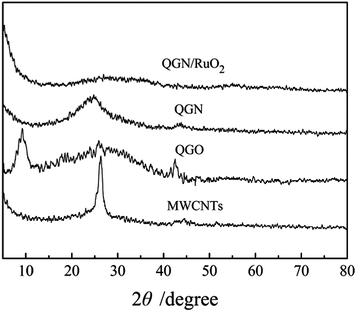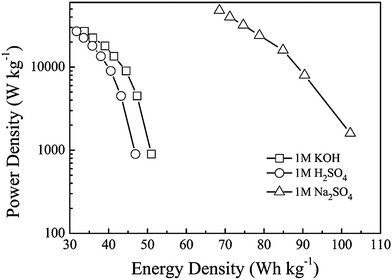Synthesis of RuO2 decorated quasi graphene nanosheets and their application in supercapacitors
Changjun Zhangab,
Haihui Zhouab,
Xiaoqing Yuab,
Dan Shanab,
Tingting Yeab,
Zhongyuan Huangab and
Yafei Kuang*ab
aState Key Laboratory for Chemo/Biosensing and Chemometrics, Hunan University, Changsha, China. E-mail: yafeik@163.com; Fax: +86-731-88713642; Tel: +86-731-88821603
bCollege of Chemistry and Chemical Engineering, Hunan University, Changsha, China. E-mail: yafeik@163.com; Fax: +86-731-88713642; Tel: +86-731-88821603
First published on 12th February 2014
Abstract
Multiwalled carbon nanotubes (MWCNTs) are split along the longitudinal direction to form quasi graphene oxide (QGO) by modified Hummers method and quasi graphene nanosheet/RuO2 (QGN/RuO2) composites with 40.0 wt% RuO2 loading are prepared by a one-step hydrothermal synthesis without any reducing agent. The characterization of morphology and structure shows that the amorphous RuO2 nanoparticles are uniformly dispersed on all the surfaces of QGN. The electrochemical measurements show that the QGN/RuO2 composites exhibit good capacitive properties compared to pure RuO2 and pure QGN in acidic, alkaline and even in neutral electrolytes. The specific capacitances of QGN/RuO2 in 1 M KOH, 1 M H2SO4, and 1 M Na2SO4 are 453.7, 415.7, 287.5 F g−1. Significantly, the QGN/RuO2 composites can achieve a high voltage window of 1.6 V and greatly increase the energy density (102.2 W h kg−1) and power density (1600 W kg−1) of supercapacitors in 1 M Na2SO4 (1 A g−1). These results demonstrate that the QGN/RuO2 composites are a promising material for high-performance supercapacitors.
1. Introduction
Supercapacitors, also called ultracapacitors, have attracted considerable attention in recent years, mainly due to their high power density, long cycle life and bridging function for the power/energy gap between traditional dielectric capacitors and batteries/fuel cells.1,2 So far, three main kinds of supercapacitor materials: carbon materials, conducting polymers and metal oxides, have been applied in carbon-based electrochemical double-layer capacitors (EDLCs),3–5 polymer-, metal oxide-based pseudocapacitors,6–8 and hybrid supercapacitors.9–12CNTs are of particular interest for the development of supercapacitor electrodes because of their unique tubular porous structure as well as high mechanical strength and high electrical conductivity, which can store much more ions and favor fast ion and electron transportation13–17 and are beneficial for characteristically high power, exceedingly stable electrochemical capacitors.18–22 However, typical CNTs with length in a range of micrometers are easily aggregated into macroscopically entangled ropes or masses, which drastically reduce their specific surface area and capacitive performance. Therefore, it limits improvement in the specific capacitance, and further production techniques are necessary to overcome agglomeration. It is reported that CNTs, as closed-curly graphene, can be split into curved graphene naonosheets. The CNTs are oxided through a remarkable transformation to graphene oxide nanosheets by modified the Hummers method.23 Through this simple process, CNTs can be split along longitudinal direction and graphene oxide nanosheets structures could be found. However, they do not form a totally flat graphene oxide nanosheets but display a tubelike structure. The as-obtained graphene oxide nanosheets possess the unique hybrid structure of 1D nanotube and 2D graphene. Therefore we named the oxided CNTs quasi graphene oxide (QGO). After reduction quasi graphene nanosheets were obtained (abbreviated as QGN), which not only avoid irreversible agglomeration but also keep the intrinsic properties of graphene. Various splitting methods have been reported to prepare QGN.24–28 A potentially scalable technique for making graphene oxide nanoribbons from longitudinal splitting of MWCNTs through chemical oxidation is available.29 This splitting method can not only increase specific surface area of CNTs, but also obtain curved graphene sheets with controllable structures to avoid irreversible agglomeration.23 Their regular pore structures and straight conductive paths can provide good ion accessibility, fast ion diffusion and high rate-tolerant capacitance.30
As a typical pseudocapacitive transition metal oxide electrode material, ruthenium oxide (RuO2), especially hydrous and amorphous RuO2, has high proton conductivity, remarkably high specific capacitance, long cycle life, and high rate capability,31–35 all of which make it the focus of research and development of supercapacitors with great potential for achieving higher energy and power densities than carbon-based EDLCs and polymer-based pseudo-capacitors, despite its high cost. However, RuO2 particles often tend to form big agglomerates, which may significantly degrade their electrochemical performance due to incomplete reaction of RuO2 during the electrochemical redox process that starts from the surface of RuO2 particles and becomes slower as the reaction proceeds, especially for agglomerated large particles.36 Therefore, the high dispersion and the decrease in size of RuO2 are the key factor to increase the capacitance of pseudocapacitive electrode materials for supercapacitors. Bi and co-workers37 showed that the RuO2 nanoparticles in the composites with a RuO2–CNT mass ratio of 6![[thin space (1/6-em)]](https://www.rsc.org/images/entities/char_2009.gif) :
:![[thin space (1/6-em)]](https://www.rsc.org/images/entities/char_2009.gif) 7 could achieve a specific capacitance of as high as 953 F g−1 at 1 mV s−1 in 1 M H2SO4, however, the range of the potential is only 0.8 V. Wu and co-workers38 reported that the hydrous RuO2/graphene sheets (GSs) composites with 38.3 wt% Ru were prepared by combining a sol–gel process and low-temperature annealing and a maximum specific capacitance of 570 F g−1 is obtained at 1 mV s−1 in 1 M H2SO4, but can't get high power density and energy density at the same time. Chen and co-workers39 deposited RuO2 nanodots homogeneously on reduced graphene oxide (RGO) sheets by one-pot hydrothermal synthesis and the best sample exhibits a maximum capacitance of 471 F g−1 at 0.5 A g−1 in 1 M H2SO4. The above researches combine carbon materials with RuO2 to make RuO2 highly disperse on the surfaces of carbon materials, which not only prevent the agglomeration of RuO2 nanoparticles and reduce the cost of electrode materials, but also can enhance capacitance and their electrochemical utilization. However, all of the above researches used 1 M H2SO4 as electrolyte at very slow scan rates or current densities to gain high specific capacitance, the power density and energy density of the composites obtained are not high and far from the ideal values of electrode materials.40
7 could achieve a specific capacitance of as high as 953 F g−1 at 1 mV s−1 in 1 M H2SO4, however, the range of the potential is only 0.8 V. Wu and co-workers38 reported that the hydrous RuO2/graphene sheets (GSs) composites with 38.3 wt% Ru were prepared by combining a sol–gel process and low-temperature annealing and a maximum specific capacitance of 570 F g−1 is obtained at 1 mV s−1 in 1 M H2SO4, but can't get high power density and energy density at the same time. Chen and co-workers39 deposited RuO2 nanodots homogeneously on reduced graphene oxide (RGO) sheets by one-pot hydrothermal synthesis and the best sample exhibits a maximum capacitance of 471 F g−1 at 0.5 A g−1 in 1 M H2SO4. The above researches combine carbon materials with RuO2 to make RuO2 highly disperse on the surfaces of carbon materials, which not only prevent the agglomeration of RuO2 nanoparticles and reduce the cost of electrode materials, but also can enhance capacitance and their electrochemical utilization. However, all of the above researches used 1 M H2SO4 as electrolyte at very slow scan rates or current densities to gain high specific capacitance, the power density and energy density of the composites obtained are not high and far from the ideal values of electrode materials.40
Here we report a facile synthesis of RuO2/QGN composites. RuO2 nanoparticles are uniformly dispersed on the surface of QGN. The QGN/RuO2 composites show excellent supercapacitor performance in acidic, alkaline and neutral electrolytes compared with pure QGN and RuO2, even at a relatively high scan rate of 100 mV s−1. Moreover, the QGN/RuO2 composites can achieve a high operating voltage of 1.6 V with high energy density and power density in neutral aqueous electrolyte.
2. Experimental section
2.1. Chemicals and materials
All reagents (Sinopharm Chemical Reagent Co., Ltd., China) were of analytical grade without further treatment. Ultrapure water was used in this study. The raw multi-walled carbon nanotubes (MWCNTs, purity >97%) with 5–15 micrometer in length and 60–100 nm in diameter were commercially supplied (L-MWNT-60100, Shenzhen Nanotech Port Co., Ltd.).2.2. Synthesis of quasi graphene oxide
Quasi graphene oxide (QGO) was synthesized by the modified Hummers' method as follows: 1 g of raw MWCNTs and 0.5 g of sodium nitrate were dispersed in 46 mL of concentrated sulfuric acid (98%) in a 250 mL flask. The mixture was stirred in an ice bath for 0.5 h. 5 g of potassium permanganate was added to the suspension under vigorous stirring. The rate of addition was carefully controlled to keep the reaction temperature lower than 10 °C. After removal of the ice bath, the mixture was stirred at 40 °C for 2 h. Then, 50 mL of water was slowly added with vigorous agitation. The diluted suspension was stirred for 30 min. After the solution cooled to room temperature, 5 mL of H2O2 (30 wt%) and 100 mL of water were added. The color of the solution changed from brown to dark green. The final mixture was centrifuged and washed with 10% HCl, ethanol and deionized water for several times. The washing process was repeated until the pH was close to 7. The final products were dried at 60 °C under vacuum for 24 h as a result of QGO.2.3. Preparation of RuO2, QGN and QGN/RuO2 composites
50 mg of the as-prepared QGO was dispersed in 50 mL of water in a round flask under ultrasonic treatment for 1 h to obtain a stable suspension. Subsequently, 13.0 mL (19.28 mM) of RuCl3·xH2O was added into the QGO solution with continuous ultrasound 0.5 h. Then the mixture was transferred into a 100 mL of Teflon autoclave and heated at 180 °C for 2 h. The hydrothermal product was filtered and washed with ethanol and water several times to remove residual chlorine ions, and finally dried under a vacuum oven at 60 °C for 12 h. Pure QGN and RuO2 were prepared using the similar method in the absence of RuO2 or QGO.2.4. Characterization of QGN/RuO2 composites
The morphologies of the as-prepared samples were observed by scanning electron microscope (SEM) (Hitachi S-4800, Japan). The structures of the samples were examined by X-ray diffraction (XRD; Philips PC-APD) with Cu Kα radiation (λ = 1.5418 Å) operating at 40 kV, 60 mA. Specific surface area and pore size distribution were calculated based on the nitrogen physical sorption (Beckman Coulter SA-3100, USA). The chemical structures of materials were tested by diffuse reflectance infrared Fourier transform spectra (FT-IR), which were collected by a NICOLET 6700 FTIR spectrometer. The thermogravimetric analysis (TGA) mounted by using a NETZSCH-409PC thermogravimetric analyzer from room temperature to 800 °C with a heating rate of 10 °C min−1 under a continuous flow of nitrogen gas was used to characterize the surface functionality of the products.2.5. Electrochemical measurements
All electrochemical measurements were carried out in a three-electrode system with an electrochemical working-station CHI 440A (Shanghai Chenhua Instrument, China). The working electrode was prepared by dropping 1 mg mL−1 of well dispersed electrode material solution (50 μL) onto a glassy carbon electrode with a diameter of 5 mm. So, the mass per unit area of the composites is 0.8 mg cm−2. A saturated calomel electrode (SCE) was served as the reference electrode and a platinum foil electrode was served as the counter electrode, respectively. The capacitive performances of electrodes were measured using cyclic voltammetry (CV) and galvanostatic charge/discharge.3. Results and discussion
3.1. Morphology and structure
The synthesis of the QGN/RuO2 composites involve two steps, and a schematic illustration is presented in Fig. 1. It is well-known that CNTs are considered as closed-curly graphene, considering that both CNT and graphite are composed of graphene, we utilized the modified Hummers method to split MWCNTs to prepare quasi graphene oxide (QGO). Subsequently, a suitable amount of RuCl3·xH2O was added into the QGO solution and the QGO/RuCl3·xH2O composites were reduced by hydrothermal synthesis without any reducing agent to obtain the final product QGN/RuO2.Fig. 2a shows a representative SEM image of MWCNTs, and Fig. 2b shows the split of nanotubes, which appears to occur along a line, similar to the ‘unzipping’ of graphite oxide affording straight-edged ribbons.41,42 The enhanced suppleness of the nanotubes causes the bending and looping after oxidation. It is evident to observe nano-trough appearance of individual MWCNTs along with a “split-log” in the SEM image. The formation of such curled nano-trough structure might be attributed to the incomplete splitting of MWCNTs. Fig. 2c shows the SEM image of the QGN, which seems like curled graphene sheets. Fig. 2d shows a typical SEM image of the as-prepared QGN/RuO2 composites. It can be seen that the RuO2 particles are uniformly dispersed on the surfaces of QGN. The QGN can prevent RuO2 particles from agglomerating and play a vital role to favor the dispersion of RuO2 particles.
Fig. 3 shows the XRD patterns of MWCNTs, QGN and QGN/RuO2. As expected, the XRD pattern of MWCNTs shows a sharp peak at 2θ = 26.3°, the interlayer spacing is about 3.5 Å. In the XRD pattern of QGO, the strong peak at 2θ = 9.2°, corresponding to an interlayer spacing of about 9.4 Å. After the hydrothermal reduction, a relatively broad peak at around 23.2° (3.9 Å) is observed in the pattern of QGN, the disappearance of the sharp peak at 2θ = 26.3° confirms the reduction of QGO, as a result of the formation of QGN. In the pattern of QGN/RuO2, no additional peak of RuO2 is observed, indicating the amorphous nature of the RuO2 in the composites.
Fig. 4 presents the N2 adsorption/desorption isotherms and pore size distribution curves of QGN and MWCNTs. According to the IUPAC classification, the as-prepared QGN exhibits type IV characteristic, which suggests the porous characteristic of QGN (Fig. 4a). The specific surface area and pore volume obtained are typically SBET = 167.45 m2 g−1 and Vt = 0.1 cm3 g−1 of QGN, which are significantly higher than SBET = 83.09 m2 g−1 and Vt = 0.013 cm3 g−1 of raw MWCNTs. In addition, from Fig. 4b it can be clearly seen that the QGN and MWCNTs have the similar pore size, and the average pore diameter is 38.86 nm. The pore size distribution ranges from 2 to 50 nm. Thus it is deduced that the prepared QGN are mesoporous materials. Moreover, the pore volume of QGN is nearly 10 times as large as that of raw MWCNTs. The above results indicate that the MWCNTs were split and unfolded. This is in consistent with the result of SEM.
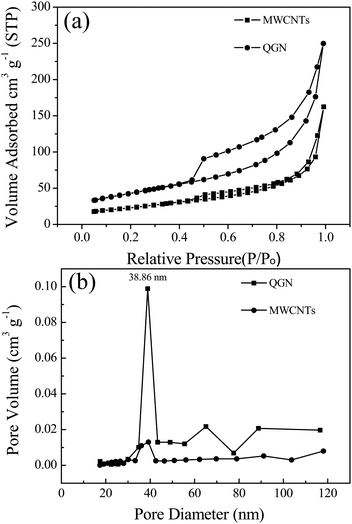 | ||
| Fig. 4 (a) Nitrogen adsorption/desorption isotherms. (b) Pore size distribution profiles of MWCNTs and QGN. | ||
Fig. 5a shows the thermal stability of QGO, QGN and QGN/RuO2. For the TGA curve of QGO, there is an obvious stage of weight loss before 200 °C due to the removal of adsorbed water and oxygen-containing groups. For QGN, there is only a light weight loss about 17% from 100 °C to 800 °C, indicating that the oxygen-containing groups have been reduced during the hydrothermal process. Compared with QGN, the weight loss of QGN/RuO2 composites (about 33%) are observed before 600 °C in the TGA curve due to the removal of adsorbed water. After 600 °C, the TGA curve shows a stable platform, demonstrating good thermal stability. Fig. 5b shows the FTIR spectra of QGO, QGN and QGN/RuO2, FTIR is a powerful tool to analyze compositions of materials. In the FTIR spectrum of QGO, the following functional groups were identified: O–H stretching at 3430 cm−1 which attributed to the residual moisture in the samples and aromatic C![[double bond, length as m-dash]](https://www.rsc.org/images/entities/char_e001.gif) C stretching vibration at 1630 cm−1, C
C stretching vibration at 1630 cm−1, C![[double bond, length as m-dash]](https://www.rsc.org/images/entities/char_e001.gif) O in COOH at 1730 cm−1, the alkoxy C–O stretching vibration at 1050 cm−1, C–OH at 1230 cm−1, and O–H deformation vibration at 1400 cm−1. This result is consistent with a graphite oxide structure.43 Compared with the QGO, the relative intensity of the C
O in COOH at 1730 cm−1, the alkoxy C–O stretching vibration at 1050 cm−1, C–OH at 1230 cm−1, and O–H deformation vibration at 1400 cm−1. This result is consistent with a graphite oxide structure.43 Compared with the QGO, the relative intensity of the C![[double bond, length as m-dash]](https://www.rsc.org/images/entities/char_e001.gif) O stretching of the –COOH at 1730 cm−1 significantly decreases, confirming that most carboxyl functionalities have been reduced. These results clearly demonstrate that the QGO was reduced after hydrothermal reduction.
O stretching of the –COOH at 1730 cm−1 significantly decreases, confirming that most carboxyl functionalities have been reduced. These results clearly demonstrate that the QGO was reduced after hydrothermal reduction.
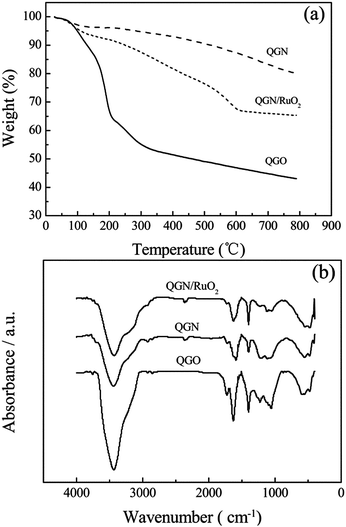 | ||
| Fig. 5 (a) TGA profiles of QGO, QGN, QGN/RuO2. (b) FTIR transmittance spectra of QGO, QGN, and QGN/RuO2. | ||
3.2. Electrochemical performance
The electrochemical performances of pure RuO2, pure QGN and QGN/RuO2 composites were tested using CV and galvanostatic charge–discharge in 1 M KOH, 1 M H2SO4 and 1 M Na2SO4 electrolytes. The QGN/RuO2 composites with different RuO2 loadings of 0, 29.6, 40.0, 59.1, 100 wt% were studied by CV and charge–discharge. Fig. 6 indicates the CV curves of QGN/RuO2 composites with different RuO2 loadings at a scan rate of 50 mV s−1. It shows that the QGN/RuO2 composites with 40 wt% RuO2 loading possess a maximum specific capacitance characteristic. Fig. 7 shows the galvanostatic charge/discharge profiles of QGN/RuO2 composites with different RuO2 loadings at a current density of 1 A g−1. The result shows that the charge and discharge time of the QGN/RuO2 composites with 40 wt% RuO2 are the longest and possess the highest specific capacitance. When the RuO2 amount is over 40% in the composites, the curve slope becomes smaller, indicating that the utilization of RuO2 decreases.44 So the composites with 40 wt% RuO2 loading were chosen for further studies.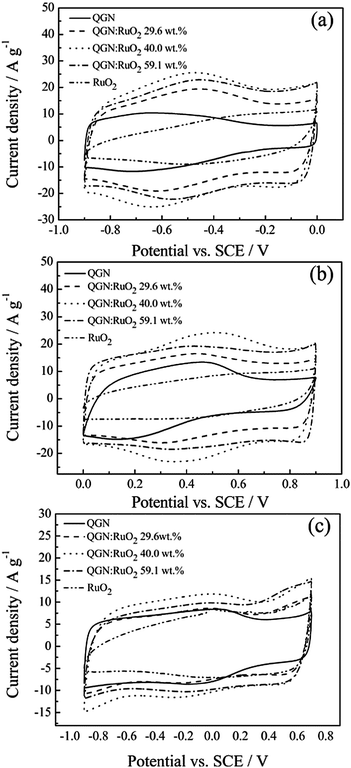 | ||
| Fig. 6 CV profiles of pure RuO2, pure QGN, QGN/RuO2 composites with different RuO2 loadings at a scan rate of 50 mV s−1 in 1 M KOH (a), 1 M H2SO4 (b) and 1 M Na2SO4 (c). | ||
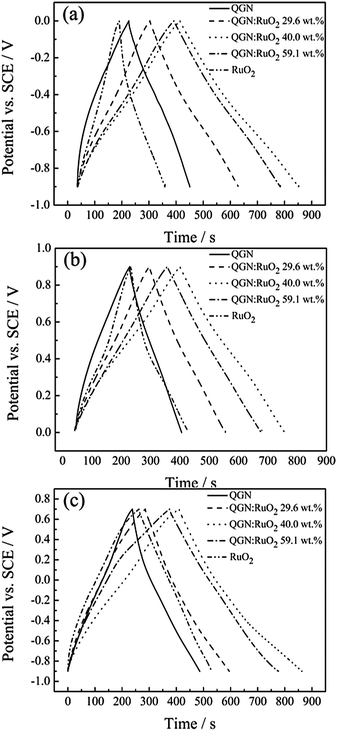 | ||
| Fig. 7 Galvanostatic charge–discharge profiles of pure RuO2, pure QGN, QGN/RuO2 composites with different RuO2 loadings at 1 A g−1 in 1 M KOH (a), 1 M H2SO4 (b) and 1 M Na2SO4 (c). | ||
Fig. 8 shows the CV curves of RuO2, QGN and the optimized QGN/RuO2 composites at a scan rate of 50 mV s−1. As seen in Fig. 8, in comparison with the pure RuO2 and QGN, the composites show the best pseudocapacitive rectangular-like and symmetrical curve, meanwhile, the loop area is the largest in three types of aqueous electrolytes. Especially noteworthy is the QGN/RuO2 composites can achieve a high operating voltage of 1.6 V without decomposition of the electrolyte (1 M Na2SO4) and keep an excellent charge and discharge behavior, it means that the composites have high energy density and power density, which is the best of that found in all of the published studies. The specific capacitance can be calculated using the equation below:
 | (1) |
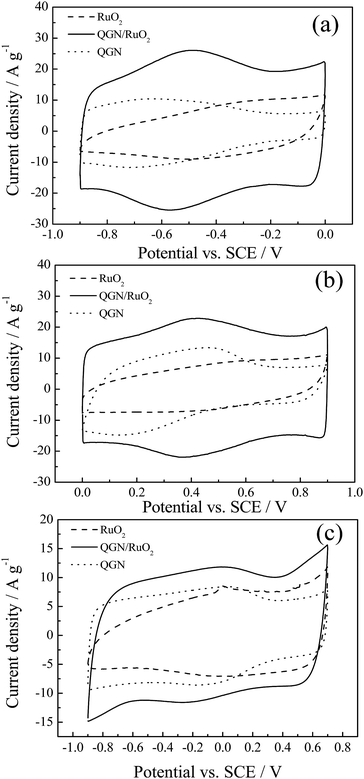 | ||
| Fig. 8 CV profiles of pure RuO2, pure QGN, QGN/RuO2 at a scan rate of 50 mV s−1 in 1 M KOH (a), 1 M H2SO4 (b) and 1 M Na2SO4 (c). | ||
| 1 M KOH (0.9 V) | 1 M H2SO4 (0.9 V) | 1 M Na2SO4 (1.6 V) | ||||
|---|---|---|---|---|---|---|
| RuO2 | 124.8a | 230.8b | 120.4a | 200.4b | 117.6a | 171.8b |
| QGN | 153.6a | 179.2b | 165.9a | 212.2b | 135.1a | 156.3b |
| QGN/RuO2 | 390.2a | 453.7b | 364.6a | 415.7b | 200.5a | 287.5b |
Fig. 9 shows the galvanostatic charge/discharge curves of pure RuO2, pure QGN, and QGN/RuO2 composites at a current density of 1 A g−1 in the three above aqueous electrolytes. As seen in Fig. 9, the QGN/RuO2 composites exhibit ideally linear and symmetrical curves within the whole potential range in three types of aqueous electrolytes. The charge and discharge time of the QGN/RuO2 composites are much longer than those of pure RuO2 and QGN at the same current density (1 A g−1). The specific capacitances of the electrodes were calculated according to the following equation:
 | (2) |
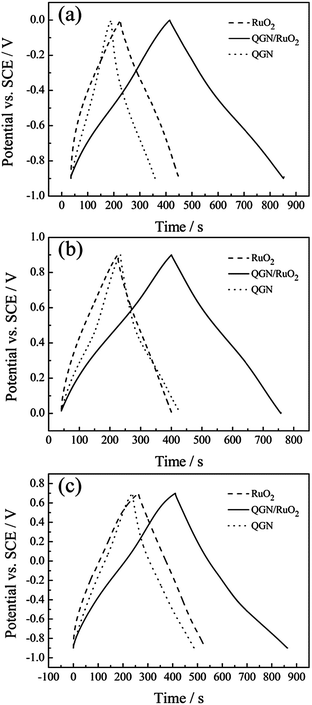 | ||
| Fig. 9 Galvanostatic charge–discharge profiles of pure RuO2, pure QGN, QGN/RuO2 at 1 A g−1 in 1 M KOH (a), 1 M H2SO4 (b) and 1 M Na2SO4 (c). | ||
Fig. 10 shows the CV curves of QGN/RuO2 electrode with various scan rates in the range of 5–100 mV s−1 in three different types of aqueous electrolytes. All the CV curves of QGN/RuO2 are close to rectangular in 1 M KOH (Fig. 10a), 1 M H2SO4 (Fig. 10b) and 1 M Na2SO4 (Fig. 10c), even at a high scan rate of 100 mV s−1, indicating an good rate capacitive behavior and a low contact resistance in the supercapacitor. The charge and discharge curves at different current densities are shown in Fig. 11. During the charging and discharging steps, the charge/discharge curves of the QGN/RuO2 composites are almost symmetric, pointing to high reversibility of the composites.
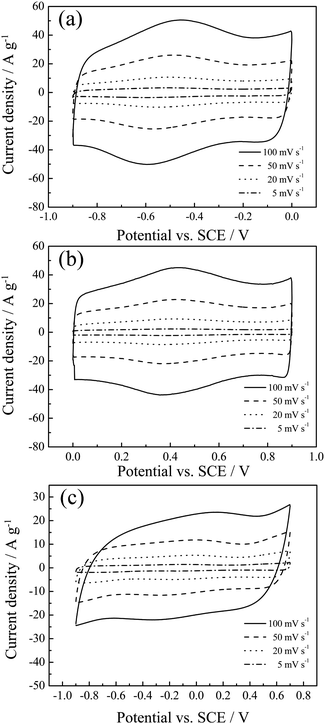 | ||
| Fig. 10 CV profiles of the QGN/RuO2 composites at a scan rate of 5, 20, 50 and 100 mV s−1 in 1 M KOH (a), 1 M H2SO4 (b) and 1 M Na2SO4 (c). | ||
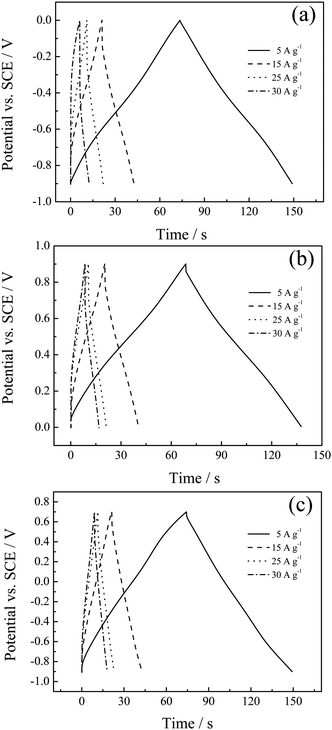 | ||
| Fig. 11 Galvanostatic charge/discharge profiles of QGN/RuO2 at current densities of 5, 15, 25 and 30 A g−1 in 1 M KOH (a), 1 M H2SO4 (b) and 1 M Na2SO4 (c). | ||
Fig. 12 shows the relationship between the specific capacitance and the current density from 1 to 30 A g−1. With increasing current density from 1 to 30 A g−1, the specific capacitance of the QGN/RuO2 composites still keep 66.12% (300 F g−1 in 1 M KOH), 67.7% (282 F g−1 in 1 M H2SO4) and 67.02% (192.7 F g−1 in 1 M Na2SO4). It indicates that the composites exhibit excellent rate capability of supercapacitor.
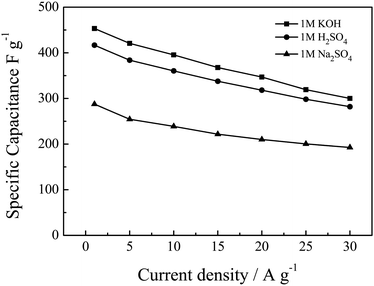 | ||
| Fig. 12 Specific capacitance of QGN/RuO2 at different current densities from 1 to 30 A g−1 in 1 M KOH, 1 M H2SO4 and 1 M Na2SO4. | ||
Energy density (E) and power density (P) of the supercapacitor were calculated according to equations as following:
 | (3) |
 | (4) |
The energy density and specific power density of pure RuO2, pure QGN and QGN/RuO2 composites were calculated at a current density of 1 A g−1 (Table 2). Obviously, the energy density and specific power density of QGN/RuO2 composites are almost twice as large as those of pure RuO2 and QGN. A synergistic enhancement effect is observed from the energy density. In spite of the specific capacitance of QGN/RuO2 composites in 1 M Na2SO4 are not as high as those in KOH and H2SO4, widening the operating voltage up to 1.6 V can significantly increase the energy density of the devices since it is proportional to the square of the cell voltage. The Ragone plots of the QGN/RuO2 composites in 1 M KOH, 1 M H2SO4 and 1 M Na2SO4 illustrate the corresponding energy/power densities (Fig. 13), with increasing power density from 900 (1 A g−1) to 27![[thin space (1/6-em)]](https://www.rsc.org/images/entities/char_2009.gif) 000 W kg−1 (30 A g−1) in 1 M KOH and 1 M H2SO4 and from 1600 (1 A g−1) to 48
000 W kg−1 (30 A g−1) in 1 M KOH and 1 M H2SO4 and from 1600 (1 A g−1) to 48![[thin space (1/6-em)]](https://www.rsc.org/images/entities/char_2009.gif) 000 W kg−1 (30 A g−1) in 1 M Na2SO4, the energy densities drop very slowly for QGN/RuO2. These results indicate that QGN/RuO2 composites exhibit good power characteristic of supercapacitors.
000 W kg−1 (30 A g−1) in 1 M Na2SO4, the energy densities drop very slowly for QGN/RuO2. These results indicate that QGN/RuO2 composites exhibit good power characteristic of supercapacitors.
| E (W h kg−1) | P (W kg−1) | |||
|---|---|---|---|---|
| RuO2 | 25.97a | 22.55b | 58.31c | 900 |
| QGN | 20.16a | 23.87b | 54.26c | 900 |
| QGN/RuO2 | 51.04a | 46.78b | 102.2c | 1600 |
Fig. 14 shows the long-term cycling stability of the QGN/RuO2 composites at 10 A g−1 for 5000 cycles in 1 M KOH, 1 M H2SO4 and 1 M Na2SO4 solution. It is clear that the specific capacitance still remains 89.9% (1 M KOH), 87.2% (1 M H2SO4) and 81.2% (1 M Na2SO4) of their initial values after 5000 cycles. It indicates that the QGN/RuO2 composites possess excellent long-term electrochemical stability. The excellent cycling performance can be attributed to the favorable function of QGN for pinning nanosized RuO2 particles, hence, effectively prevent these nanoparticles from aggregating, the existence of QGN enables the high conductivity of the QGN/RuO2 composites. Additionally, it is seen that the QGN/RuO2 composites show outstanding performances in both acidic and alkaline electrolytes, even in neutral electrolyte, indicating that the QGN/RuO2 composites are compatible with a wide range of electrolytes.
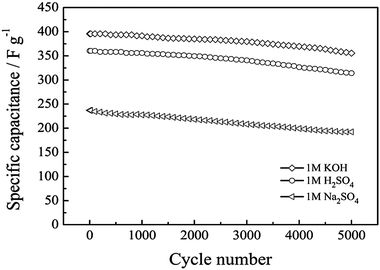 | ||
| Fig. 14 Specific capacitance of the QGN/RuO2 composites at 10 A g−1 for 5000 cycles in 1 M KOH, 1 M H2SO4 and 1 M Na2SO4. | ||
4. Conclusions
The QGN/RuO2 composites with good performances can be synthesized by a one-step hydrothermal route without using any reducing agent. The as-prepared composites can be used as superior electrode material for supercapacitors with high specific capacitance and significantly enhanced energy and power densities as well as improved cycling performance compared with pure RuO2 and QGN. The improved electrochemical performance can be attributed to the multiple functions of the QGN/RuO2 composites, including: (i) by using Hummers method to split and cut CNTs, the real specific surface area and the anti-agglomeration ability of the composites are enhanced. (ii) QGN provides excellent conditions for RuO2 nanoparticles dispersing uniformly and enhancing the conductivity of RuO2, (iii) the combination of RuO2 and QGN has the advantages of both the pseudocapacitance of RuO2 and the stable double-layer capacitance of QGN. These results demonstrate the attractive potential of the QGN/RuO2 composites for high-performance supercapacitors.Acknowledgements
This work was supported by National Natural Science Foundation of China (Grant no. 51071067, 21271069, J1210040, and 51238002) and Science and Technology Program of Hunan Province (2013GK3015).Notes and references
- C. Largeot, C. Portet, J. Chmiola, P. Taberna, Y. Gogotsi and P. Simon, J. Am. Chem. Soc., 2008, 130, 2730–2731 CrossRef CAS PubMed.
- S. G. Kandalkar, D. S. Dhawale, C. K. Kim and C. D. Lokhande, Synth. Met., 2010, 160, 1299–1302 CrossRef CAS PubMed.
- E. Frackowiak, Phys. Chem. Chem. Phys., 2007, 9, 1774–1785 RSC.
- D. W. Wang, F. Li, M. Liu, G. Q. Lu and H. M. Cheng, Angew. Chem., Int. Ed., 2008, 47, 373–376 CrossRef CAS PubMed.
- K. H. An, W. S. Kim, Y. S. Park, J. M. Moon, D. J. Bae, S. C. Lim, Y. S. Lee and Y. H. Lee, Adv. Funct. Mater., 2001, 11, 387–392 CrossRef CAS.
- J. P. Zheng, P. J. Cygan and T. R. Jow, J. Electrochem. Soc., 1995, 142, 2699–2703 CrossRef CAS PubMed.
- C. Ye, Z. M. Lin and S. Z. Hui, J. Electrochem. Soc., 2005, 152, A1272–A1278 CrossRef CAS PubMed.
- Y. G. Wang, H. Q. Li and Y. Y. Xia, Adv. Mater., 2006, 18, 2619–2623 CrossRef CAS.
- B. E. Conway and W. G. Pell, J. Solid State Electrochem., 2003, 7, 637–644 CrossRef CAS PubMed.
- K. H. An, K. K. Jeon, J. K. Heo, S. C. Lim, D. J. Bae and Y. H. Lee, J. Electrochem. Soc., 2002, 149, A1058–A1062 CrossRef CAS PubMed.
- L. Z. Fan, Y. S. Hu, J. Maier, P. Adelhelm, B. Smarsly and M. Antonietti, Adv. Funct. Mater., 2007, 17, 3083–3085 CrossRef CAS.
- D. W. Wang, H. T. Fang, F. Li, Z. G. Chen, Q. S. Zhong, G. Q. Lu and H. M. Cheng, Adv. Funct. Mater., 2008, 18, 3787–3793 CrossRef CAS.
- C. C. Hu, K. H. Chang, M. C. Lin and Y. T. Wu, Nano Lett., 2006, 6, 2690–2695 CrossRef CAS PubMed.
- C. Niu, E. K. Sichel, R. Hoch, D. Moy and H. Tennent, Appl. Phys. Lett., 1997, 70, 1480–1484 CrossRef CAS PubMed.
- D. N. Futaba, K. Hata, T. Yamada, T. Hiraoka, Y. Hayamizu, Y. Kakudate, O. Tanaike, H. Hatori, M. Yumura and S. Iijima, Nat. Mater., 2006, 5, 987–994 CrossRef CAS PubMed.
- E. Frackowiak, K. Jurewicz, S. Delpeux and F. Beguin, J. Power Sources, 2001, 97–98, 822–825 CrossRef CAS.
- T. Bordjiba and L. H. D. M. Mohamedi, Adv. Mater., 2008, 20, 815–819 CrossRef CAS.
- K. H. An, W. S. Kim, Y. S. Park, Y. C. Choi, S. M. Lee, D. C. Chung, D. J. Bae and S. C. Lim, Adv. Mater., 2001, 13, 497–500 CrossRef CAS.
- C. S. Du and N. Pan, Nanotechnology, 2006, 17, 5314–5318 CrossRef CAS.
- A. L. M. Reddy, F. E. Amitha, I. Jafri and S. Ramaprabhu, Nanoscale Res. Lett., 2008, 3, 145–151 CrossRef.
- C. G. Liu, M. Liu, F. Li and H. M. Cheng, Appl. Phys. Lett., 2008, 92, 143108 CrossRef PubMed.
- C. Liu, F. Li, L. P. Ma and H. M. Cheng, Adv. Mater., 2010, 22, 28–62 CrossRef PubMed.
- H. Wang, Y. Wang, Z. Hu and X. Wang, ACS Appl. Mater. Interfaces, 2012, 4, 6827–6834 CAS.
- L. Jiao, L. Zhang, X. Wang, G. Diankov and H. Dai, Nature, 2009, 458, 877–880 CrossRef CAS PubMed.
- A. G. Cano-Marquez, F. J. Rodrguez-Macas, J. Campos-Delgado, C. G. Espinosa-Gonzalez, F. Tristan-Lopez, D. Ramrez-Gonz alez, D. A. Cullen, D. J. Smith, M. Terrones and Y. I. Veg-Cantu, Nano Lett., 2009, 9, 1527–1533 CrossRef CAS PubMed.
- A. Morelos-Gomez, S. M. Vega-Daz, V. J. Gonzalez, F. Tristan-Lopez, R. Cruz-Silva, F. Fujisawa, H. Muramatsu, T. Hayashi, X. Mi and Y. F. Shi, et al., ACS Nano, 2012, 6, 2261–2272 CrossRef CAS PubMed.
- A. L. Elias, A. R. Botello-Mendez, D. Meneses-Rodrguez, V. J. Gonzalez, D. Ramrez-Gonzalez, L. J. Ci, E. Munoz-Sandoval, P. M. Ajayan, H. Terrones and M. Terrones, Nano Lett., 2010, 10, 366–372 CrossRef CAS PubMed.
- K. Kim, A. Sussman and A. Zettl, ACS Nano, 2010, 4, 1362–1366 CrossRef CAS PubMed.
- D. V. Kosynkin, A. L. Higginbotham, A. Sinitskii, J. R. Lomeda, A. Dimiev, B. Katherine Price and J. M. Tour, Nature, 2009, 458, 872–877 CrossRef CAS PubMed.
- B. Kim, H. Chung and W. Kim, Nanotechnology, 2012, 23, 155401 CrossRef PubMed.
- H. Lee, M. S. Cho, I. H. Kim, J. D. Namand and Y. Lee, Synth. Met., 2010, 160, 1055–1059 CrossRef CAS PubMed.
- I. H. Kim and K. B. Kim, J. Electrochem. Soc., 2006, 153, A383–A389 CrossRef CAS PubMed.
- Q. X. Jia, S. G. Song, X. D. Wu, J. H. Cho, S. R. Foltyn, A. T. Findikoglu and J. L. Smith, Appl. Phys. Lett., 1996, 68, 1069–1071 CrossRef CAS PubMed.
- K. Sakiyama, S. Onishi, K. Ishihara, K. Orita, T. Kajiyama, N. Hosoda and T. Hara, J. Electrochem. Soc., 1993, 140, 834–839 CrossRef CAS PubMed.
- Y. R. Zhu, X. B. Ji and C. C. Pan, et al., Energy Environ. Sci., 2013, 6, 3665–3675 CAS.
- H. F. Li, R. D. Wan and R. Cao, Microporous Mesoporous Mater., 2008, 111, 32–38 CrossRef CAS PubMed.
- R. R. Bi, X. L. Wu, F. F. Cao, L. Y. Jiang, Y. G. Guo and L. J. Wan, J. Phys. Chem. C, 2010, 114, 2448–2451 CAS.
- Z. S. Wu, D. W. Wang, W. C. Ren, J. P. Zhao, G. M. Zhou, F. Li and H. M. Cheng, Adv. Funct. Mater., 2010, 20, 3595–3602 CrossRef CAS.
- Y. Chen, X. Zhang, D. C. Zhang and Y. W. Ma, J. Alloys Compd., 2012, 511, 251–256 CrossRef CAS PubMed.
- M. D. Stoller and R. S. Ruoff, Energy Environ. Sci., 2010, 3, 1294–1301 CAS.
- J. L. Li, et al., Phys. Rev. Lett., 2006, 96, 176101 CrossRef.
- P. M. Ajayan and B. I. Yakobson, Nature, 2006, 441, 818–819 CrossRef CAS PubMed.
- S. Stankovich, D. A. Dikin, R. D. Piner, K. A. Kohlhaas, A. Kleinhammes, Y. Jia, Y. Wu, S. T. Nguyen and R. S. Ruoff, Carbon, 2007, 45, 1558–1565 CrossRef CAS PubMed.
- L. J. Deng, J. F. Wang and G. Zhu, et al., J. Power Sources, 2014, 248, 407–415 CrossRef CAS PubMed.
| This journal is © The Royal Society of Chemistry 2014 |


